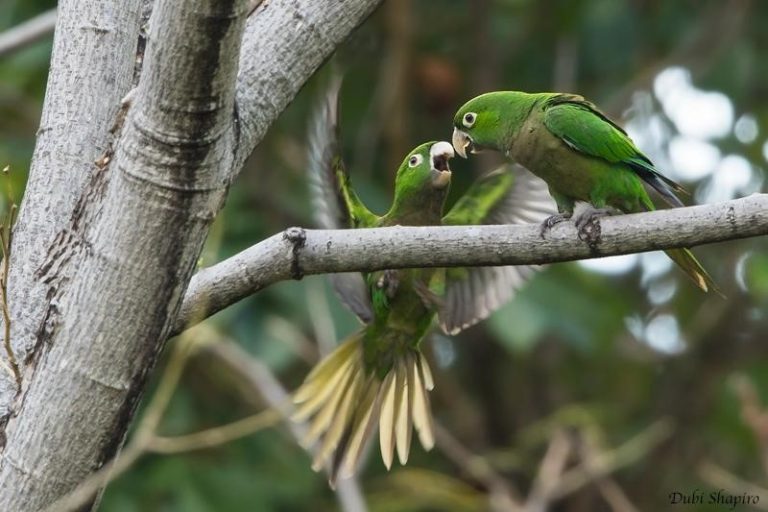Birdfinding.info ⇒ Generally common across the lowlands and foothills of Jamaica. Readily found at sites such as Rocklands Bird Sanctuary, Stewart Town, Robin’s Bay, Hope Gardens, San San, Ecclesdown Road, and throughout Cockpit Country. In the southwestern D.R., it is often found on the Rabo de Gato Trail and along Zapotén Road below La Placa.
Jamaican Parakeet
Eupsittula nana
Endemic to Jamaica; introduced to Hispaniola. Common in wooded and semiopen habitats throughout Jamaica, including agricultural and urban areas.
Also locally common and increasing in the southwestern Dominican Republic, mainly in the foothills of the Sierra de Bahoruco, where it was apparently introduced.
Identification
The only native parakeet on Jamaica. Green overall, with brownish underparts, often darkest on the throat and chest.
The upperside of the spread wing has an extensive deep blue patch on the secondaries and inner primaries, with a black trailing edge.
In the southwestern D.R. and perhaps elsewhere on Hispaniola, it occurs alongside Hispaniolan Parakeet, which is all-green except for the underside of the spread wing—with yellowish flight feathers and bright scarlet shoulder patch.
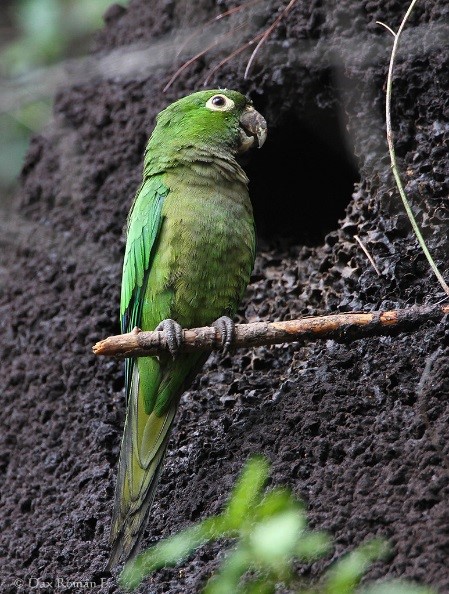
Jamaican Parakeet, at nest in termite mound. (Sierra de Bahoruco, Dominican Republic; August 26, 2014.) © Dax M. Román E.
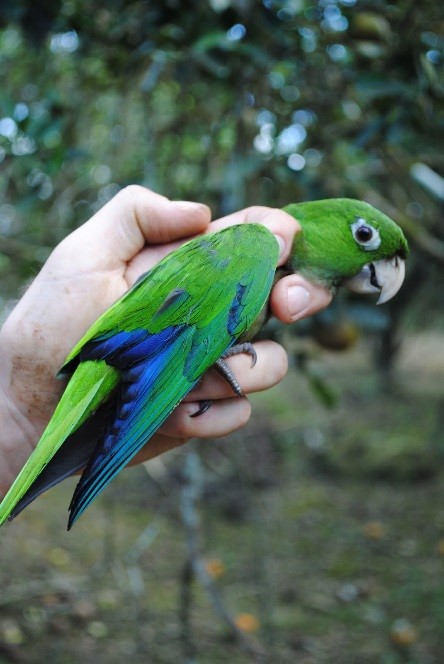
Jamaican Parakeet, showing pattern of deep blue and black in flight feathers. (March 2012.) © Alan Hunter Kneidel
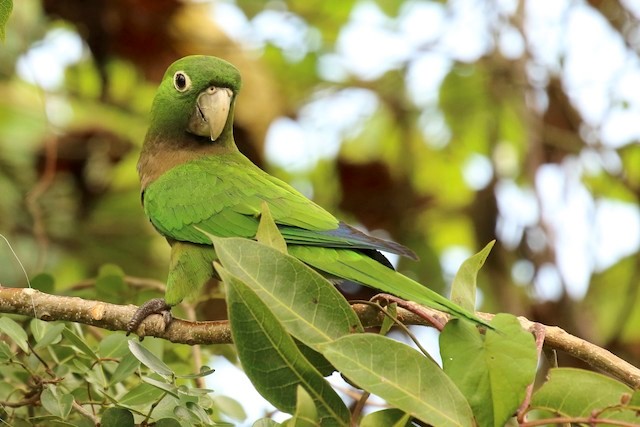
Jamaican Parakeet. (Rocklands Bird Sanctuary, Jamaica; January 3, 2018.) © Knut Hansen
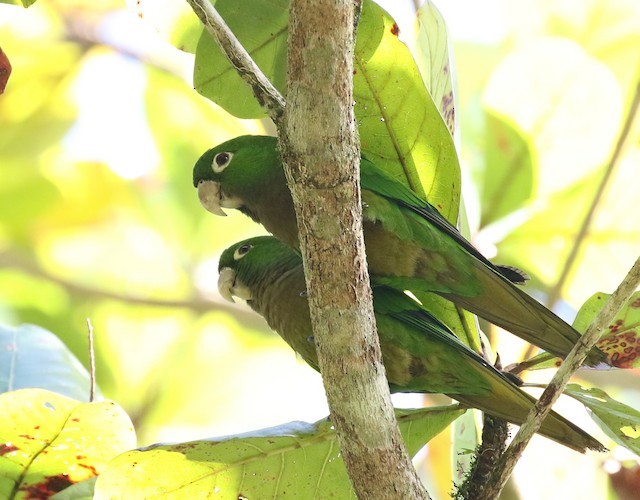
Jamaican Parakeets. (Stewart Town, Jamaica; January 27, 2019.) © Matthew Grube
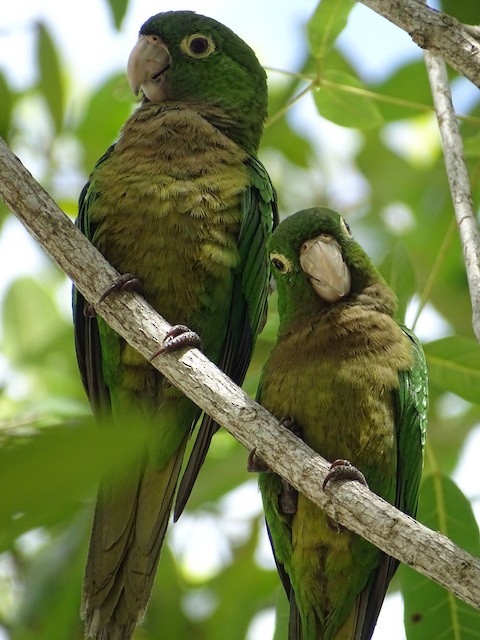
Jamaican Parakeet. (Negril, Jamaica; February 17, 2018.) © Nancy LiPetri
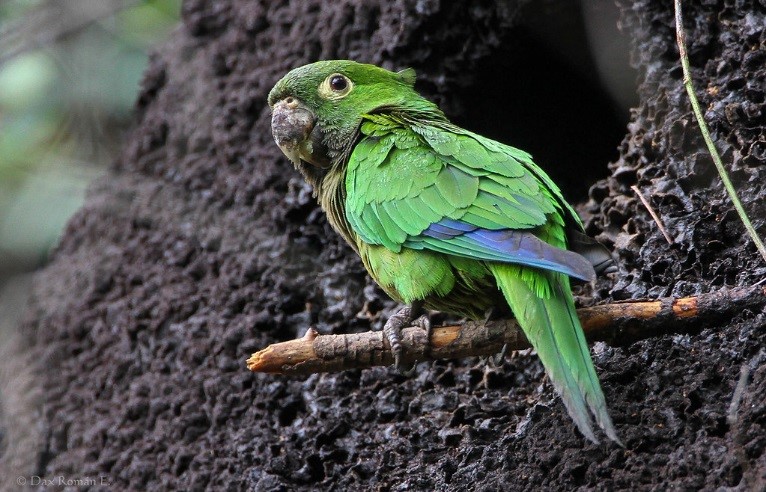
Jamaican Parakeet, at nest in termite mound. (Sierra de Bahoruco, Dominican Republic; August 26, 2014.) © Dax M. Román E.
Notes
Monotypic species. Traditionally considered conspecific with Aztec Parakeet of Mexico and Central America, collectively the Olive-throated Parakeet, E. nana, but the Handbook of the Birds of the World treats Jamaican and Aztec Parakeets as separate species, citing size and plumage differences, supported by genetic analyses of relatedness.
IUCN Red List Status: Near Threatened.
The Jamaican Parakeet population on Hispaniola is likely introduced. When it was discovered in the foothills of the Sierra de Bahoruco in the 1980s, the remoteness of the area suggested the possibility that it was an overlooked natural population, possibly even a distinct subspecies. Genetic analysis has shown that the Hispaniolan population likely arrived from Jamaica recently, which suggests human assistance.
References
BirdLife International 2016. Eupsittula nana. The IUCN Red List of Threatened Species 2016: e.T45418540A95147758. http://dx.doi.org/10.2305/IUCN.UK.2016-3.RLTS.T45418540A95147758.en. (Accessed May 7, 2019.)
Collar, N., P. Boesman and G.M. Kirwan. 2019. Jamaican Parakeet (Eupsittula nana). In: del Hoyo, J., A. Elliott, J. Sargatal, D.A. Christie, and E. de Juana (eds.). Handbook of the Birds of the World Alive. Lynx Edicions, Barcelona. http://www.hbw.com/node/54648. (Accessed May 7, 2019.)
eBird. 2019. eBird: An online database of bird distribution and abundance. Cornell Lab of Ornithology, Ithaca, N.Y. http://www.ebird.org. (Accessed May 7, 2019.)
Forshaw, J.M. 2010. Parrots of the World. Princeton University Press, Princeton, N.J.
Haynes-Sutton, A., A. Downer, R. Sutton, and Y.-J. Rey-Millet. 2009. A Photographic Guide to the Birds of Jamaica. Princeton University Press, Princeton, N.J.
Latta, S.C., A.K. Townsend and I.J. Lovette. 2010. The origins of the recently discovered Hispaniolan Olive-throated Parakeet: A phylogeographic perspective on a conservation conundrum. Caribbean Journal of Science 46:143-149.
Raffaele, H., J. Wiley, O. Garrido, A. Keith, and J. Raffaele. 1998. A Guide to the Birds of the West Indies. Princeton University Press, Princeton, N.J.
